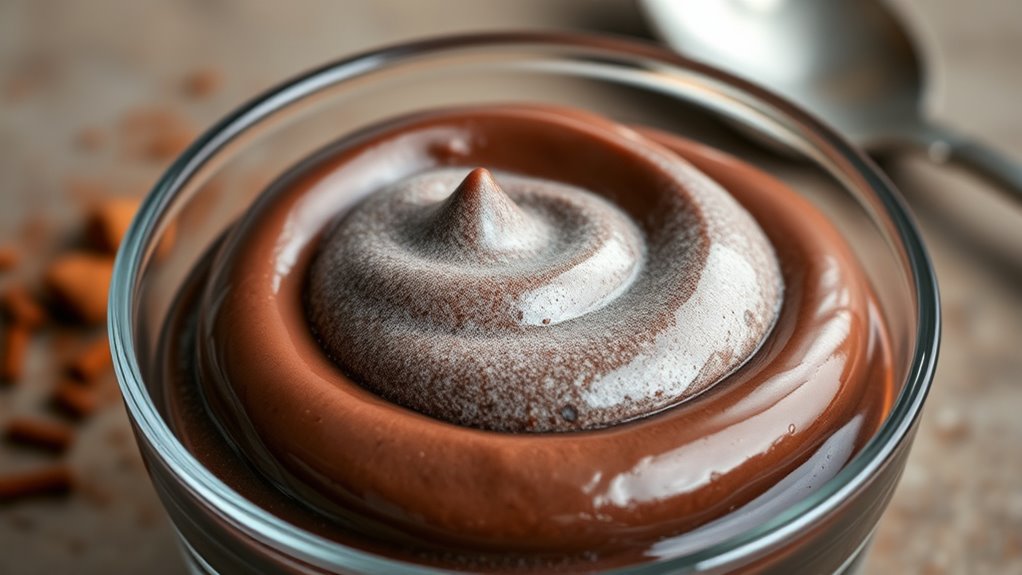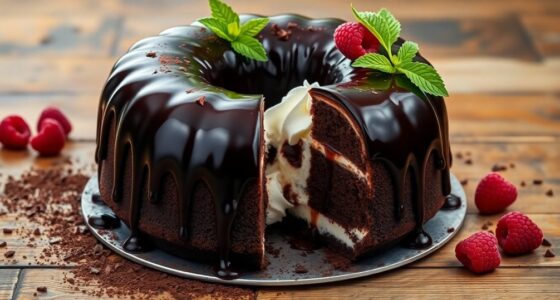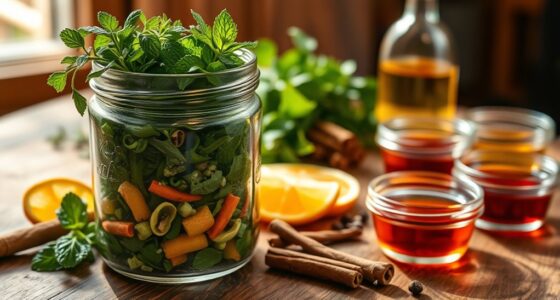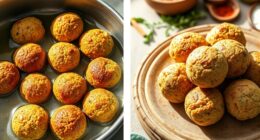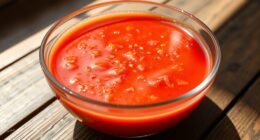Vegan chocolate mousse with aquafaba relies on the science of how this bean cooking liquid mimics egg whites by trapping air through its proteins and starches, creating a fluffy, stable foam. By whipping aquafaba to stiff peaks and carefully folding it into melted chocolate, you achieve a light, airy texture. Stabilizing methods, proper technique, and environmental awareness help prevent collapse. Keep exploring to uncover the detailed tips and tricks for perfect results.
Key Takeaways
- Aquafaba’s proteins and starches trap air, creating a light, fluffy foam ideal for vegan mousse.
- Proper whipping and gentle folding preserve aquafaba’s air bubbles, ensuring optimal mousse texture.
- Stabilizers like acid or agar help maintain foam stability and prevent deflation during preparation.
- Using high-protein chickpea aquafaba and chilled equipment enhances foaming ability and volume.
- Understanding aquafaba’s chemistry guides techniques for achieving stable, airy, and creamy vegan chocolate mousse.
Understanding Aquafaba: The Secret Ingredient
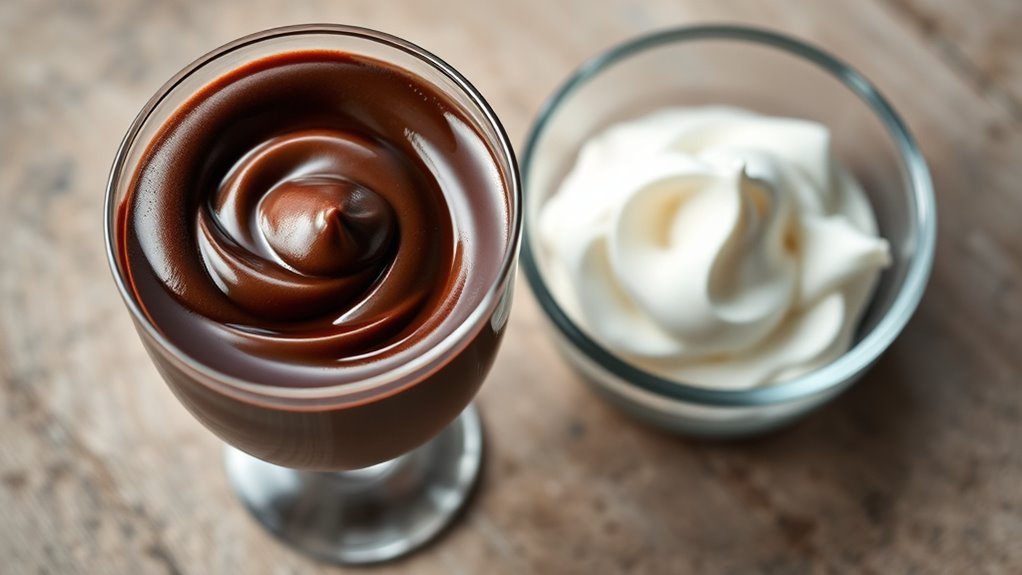
Aquafaba is the magic behind many vegan desserts, including this chocolate mousse. It’s the liquid from cooked chickpeas or other beans, often discarded but surprisingly versatile. When whipped, aquafaba mimics egg whites, creating a light, airy structure. Its unique proteins and starches allow it to trap air, giving your mousse that fluffy texture you’re after. The best part? It’s completely plant-based and allergen-friendly. You don’t need any fancy ingredients—just the aquafaba from a can of chickpeas or homemade beans. Understanding how to work with aquafaba means you can transform simple pantry staples into a decadent, vegan dessert. Mastering its properties release endless possibilities for creating light, creamy, and satisfying treats without using eggs or dairy. Understanding aquafaba’s properties is essential for achieving the perfect mousse consistency.
The Chemistry Behind Aquafaba’s Meringue-Like Properties

The key to aquafaba’s meringue-like properties lies in its unique combination of proteins and starches, which interact at the molecular level to trap air during whipping. When you beat aquafaba, the proteins unfold and form a network that stabilizes the air bubbles, creating foam. Simultaneously, starches present help strengthen this foam structure, making it more stable and less likely to collapse. The proteins act like tiny scaffolds, wrapping around air pockets, while starches add viscosity and support. This synergy allows aquafaba to mimic egg whites, producing a light, airy foam essential for meringue textures. Understanding the chemistry behind aquafaba’s properties enables better control and optimization in your vegan baking. Additionally, insights from AI in food science are beginning to inform how we can further enhance vegan ingredients like aquafaba through innovative processing techniques. Furthermore, ongoing research into plant-based proteins offers promising avenues for improving aquafaba’s functional qualities. Recognizing food structuring methods can also help optimize aquafaba’s foaming capacity and stability for various culinary applications. Moreover, studying protein-starch interactions provides deeper understanding of how to tailor aquafaba’s properties for specific recipes.
Preparing the Perfect Aquafaba for Mousse

To prepare the perfect aquafaba, start by choosing the right beans—canned chickpeas are a popular option. Store your aquafaba in an airtight container in the fridge if you’re not using it immediately, to keep it fresh. When ready, focus on achieving the ideal foam by whipping it to stiff peaks; this step is key for a light, airy mousse. Additionally, incorporating a small amount of acid, such as lemon juice or vinegar, can help stabilize the foam and improve its volume stability of aquafaba. Using a clean, dry mixing bowl and beaters can also significantly enhance the foam formation process. Understanding the Glycolic Acid Benefits for Skin can also inspire creative variations in your mousse, making it a delightful culinary experience. Furthermore, experimenting with different wall organization systems can help keep your kitchen tools and ingredients organized for easier preparation.
Choosing the Right Beans
Choosing the right beans is essential for creating stable, airy aquafaba that holds up perfectly in your vegan chocolate mousse. Not all beans produce the same quality of aquafaba, so selecting the best ones makes a difference. Look for beans with high protein content and a smooth cooking liquid to ensure better foaming ability. Canned chickpeas are a popular choice because they’re convenient and consistent. Opt for organic or high-quality beans to avoid additives that could affect the aquafaba’s stability. Keep in mind that different brands or types of beans may yield varying results, so some experimentation might be needed. Ultimately, choosing the right beans ensures you get a thick, glossy aquafaba that whips up perfectly for your mousse.
Proper Aquafaba Storage
Once you’ve prepared your aquafaba, storing it properly guarantees it maintains its whip-ready consistency. Transfer the aquafaba into an airtight container to prevent contamination and absorption of odors from other foods. Keep it refrigerated at or below 40°F (4°C) if you plan to use it within 24 hours. For longer storage, freeze the aquafaba in ice cube trays, then transfer the frozen cubes to a sealed bag or container. Label it with the date to track freshness. Thawed aquafaba may be be slightly less stable, but it still works well for whipping. Always give it a gentle swirl or stir before use to re-incorporate any separation. Proper storage ensures your aquafaba stays fresh, ready to create the perfect vegan mousse. Additionally, understanding the stability of aquafaba can help you achieve consistent whipping results. Maintaining the foam structure is essential for achieving the desired lightness in your mousse. Temperature fluctuations can compromise its whipping ability, so avoid repeated temperature changes during storage. Being aware of the storage duration can help prevent deterioration and ensure optimal performance.
Achieving Perfect Foam
Achieving the perfect foam starts with selecting high-quality aquafaba and preparing it correctly. Fresh, well-stored aquafaba whips better and creates a more stable foam. To guarantee ideal results, consider these tips:
- Use aquafaba from canned or cooked chickpeas, ensuring it’s free of added salt or oil.
- Chill the aquafaba in the fridge for at least 30 minutes before whipping.
- Add a pinch of cream of tartar or lemon juice to stabilize the foam and improve volume.
Incorporating Aquafaba Into Your Chocolate Mixture
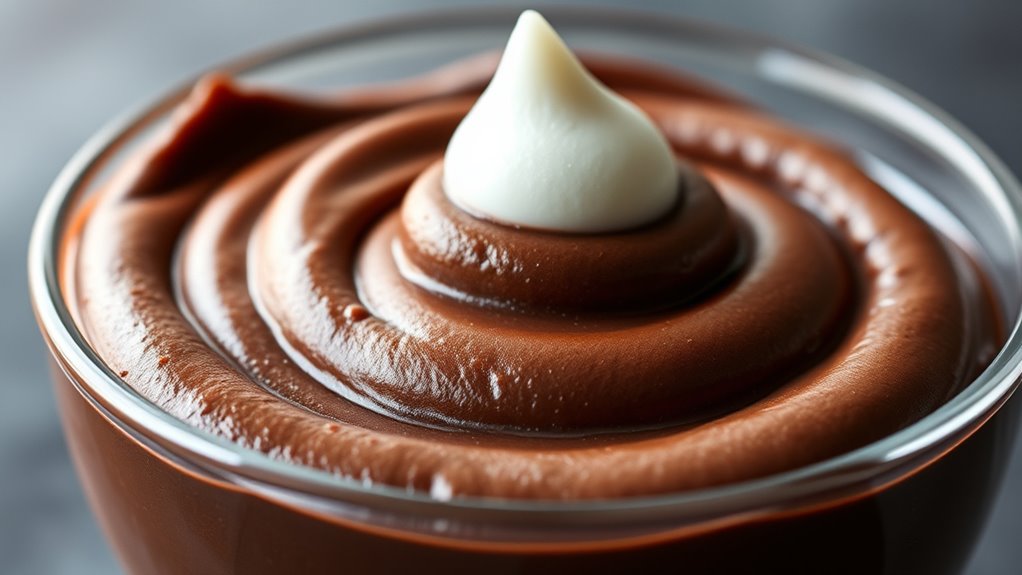
Incorporating aquafaba into your chocolate mixture is a simple way to add lightness and a fluffy texture without using eggs. First, make sure your aquafaba is whipped to soft peaks, which creates the airy base needed for a mousse. Gently fold the whipped aquafaba into your melted chocolate, starting with a small portion to lighten the mixture. Use a spatula to fold carefully, maintaining as much air as possible. This process ensures the mousse will be fluffy and smooth. Avoid stirring vigorously, as that can deflate the aquafaba’s whipped structure. Once fully incorporated, transfer the mixture into serving dishes and refrigerate. Proper folding techniques are crucial for achieving the ideal texture and consistency. Incorporating techniques like gentle folding helps maintain the aeration and creates a more luxurious mousse. Additionally, understanding the scientific properties of aquafaba can help optimize the fluffiness and stability of your dessert. For example, protein and starch content in aquafaba contribute to its foaming ability and structural stability. This method guarantees a light, airy texture that mimics traditional mousse, all without eggs or dairy.
Techniques for Achieving the Ideal Texture
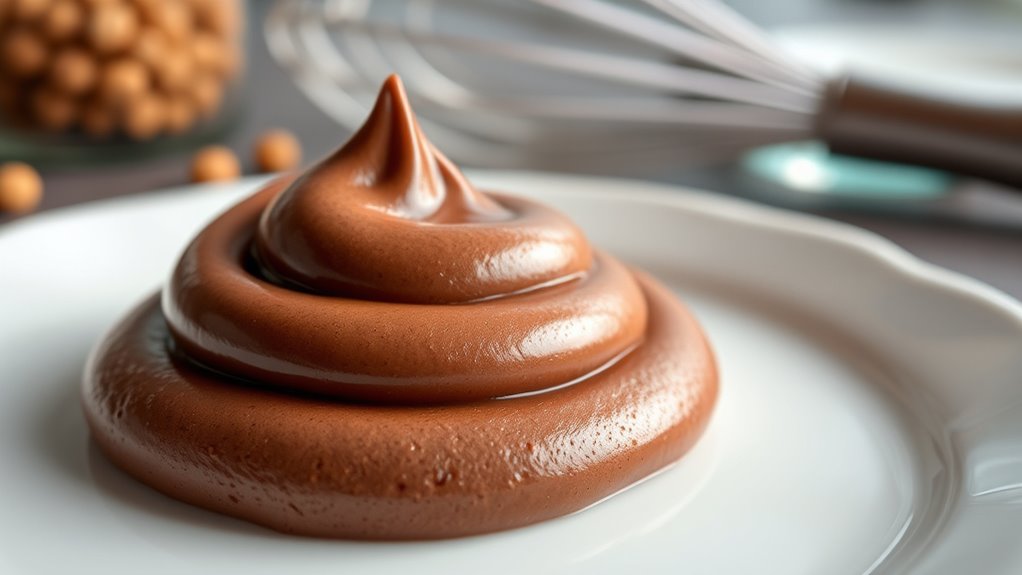
To achieve the ideal texture in vegan chocolate mousse, paying attention to the folding process is essential. You want to gently incorporate whipped aquafaba into the chocolate mixture without deflating the air bubbles. Use a spatula to fold carefully, turning the mixture over and under to maintain lightness. Keep your movements slow and gentle to prevent loss of volume. Incorporating proper folding techniques can help maintain the mousse’s delicate structure during folding. Additionally, understanding the beach environment, such as wave action and wind, can provide insights into how to handle delicate structures and maintain stability during preparation. For example, being aware of the types of headphone jacks and their compatibility can ensure your equipment functions correctly, much like understanding the nuances of a delicate folding process. Recognizing how celebrity transformations have evolved over time can inspire confidence in your own culinary experiments and adaptability.
Tips for Stabilizing and Fluffing the Mousse
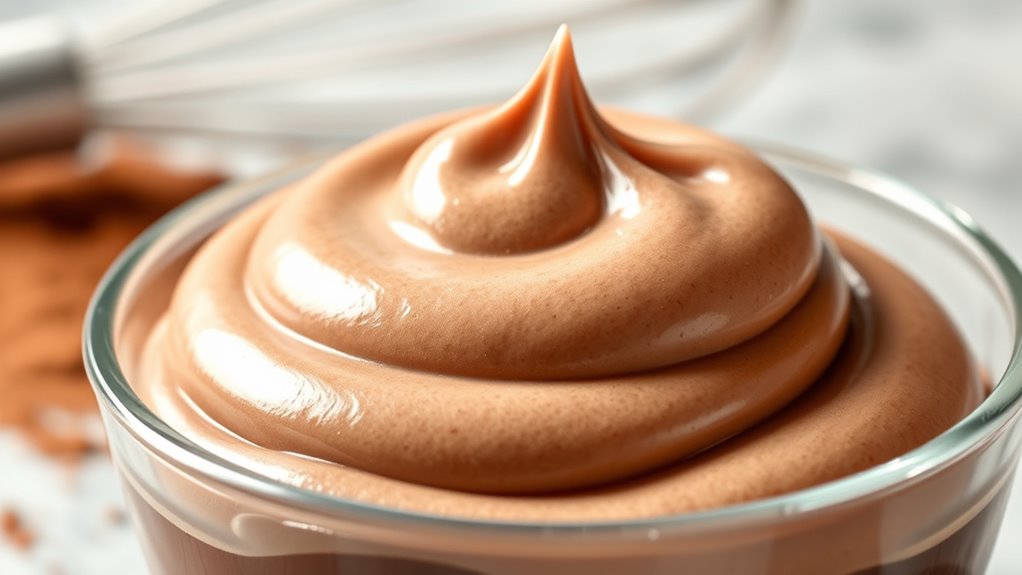
Once you’ve folded the whipped aquafaba into the chocolate mixture, the next step is to stabilize and fluff the mousse to guarantee it holds its shape. To do this, gently fold in a small amount of aquafaba at a time, maintaining a light touch to preserve the airiness. Use a spatula to lift and fold, avoiding stirring or overmixing. If you want extra stability, add a teaspoon of natural stabilizer like agar powder dissolved in a little hot water, then fold it in carefully. Chill the mousse for at least 30 minutes before serving; this helps it set and firm up. Finally, gently fluff the mousse with a spatula before serving to achieve a light, airy texture that holds beautifully.
Troubleshooting Common Aquafaba Mousse Challenges
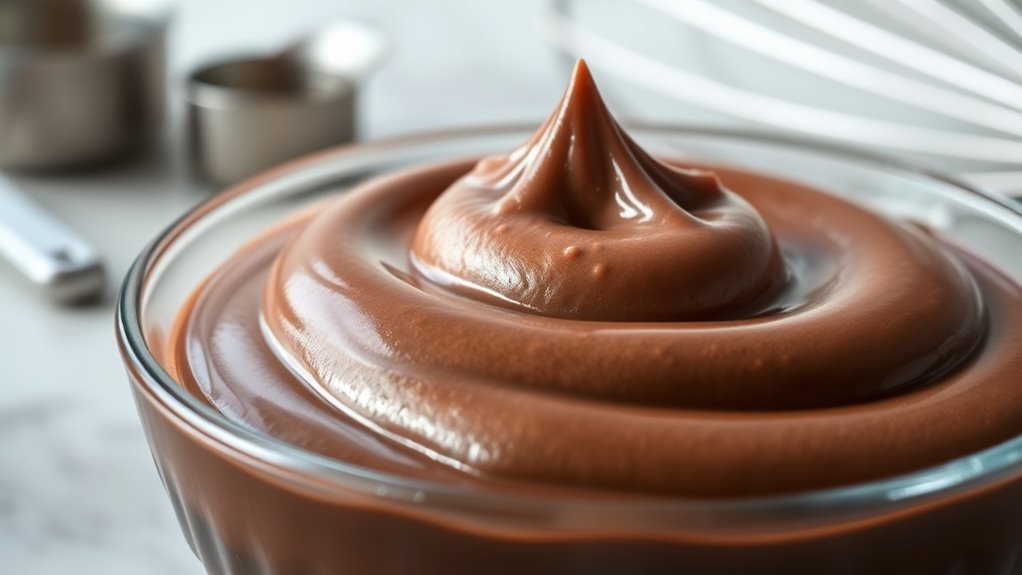
If your aquafaba isn’t forming stiff peaks, it might be too warm or not beaten long enough. To prevent deflation, fold in ingredients gently and avoid overmixing. Addressing these issues helps guarantee your mousse stays light and fluffy.
Achieving Stiff Peaks
Achieving stiff peaks with aquafaba can be tricky, but with the right technique, you can master it easily. First, use chilled aquafaba; cold liquid whips better. Next, ensure your mixing bowl and beaters are completely clean and dry—any residue can hinder volume. Finally, beat the aquafaba on high speed until it forms firm, glossy peaks that hold their shape. Keep an eye out for these key signs:
- The peaks stand tall and don’t droop
- The mixture is shiny and smooth
- You can hold the bowl upside down without it sliding out
If you notice the peaks are soft or watery, it’s a sign to keep beating or start over with fresher aquafaba. Mastering this step ensures your mousse will have the perfect airy texture.
Preventing Deflation
Even when you’ve successfully whipped aquafaba into stiff, glossy peaks, the risk of deflation remains if you don’t manage it carefully. To prevent this, avoid overmixing the whipped aquafaba once you’ve added other ingredients. Gently fold in your chocolate or flavorings using a spatula, taking care not to deflate the foam. When incorporating the aquafaba into your mousse base, do so gradually and with light, gentle movements. Also, don’t rush the process—work calmly and efficiently. Keep the whipped aquafaba at room temperature until you’re ready to fold it into the rest of the ingredients. Once combined, don’t let the mixture sit out too long before serving, as exposure to air can cause it to deflate quickly. Proper handling ensures your mousse stays fluffy and airy.
Frequently Asked Questions
Can I Use Canned Beans Other Than Chickpeas for Aquafaba?
You wonder if you can use canned beans other than chickpeas for aquafaba. While chickpeas are the most common, some other beans like white beans or kidney beans might work, but their aquafaba may not whip as well or have the same neutral flavor. It’s best to experiment carefully, as the consistency and foaming properties can vary. Stick to chickpeas for the most reliable results in recipes like vegan mousse.
How Long Can I Store Vegan Chocolate Mousse Made With Aquafaba?
You can store your vegan chocolate mousse with aquafaba in the fridge for up to 2-3 days. Make sure to keep it in an airtight container to prevent it from absorbing other odors. For best texture and flavor, consume it within this timeframe. If you notice any changes in appearance or smell, it’s safest to discard it. Remember, the sooner you enjoy it, the fresher it will taste!
Is Aquafaba Suitable for People With Bean Allergies?
Ever wondered if aquafaba is safe for those with bean allergies? It’s derived from cooking beans, so if you’re allergic to beans, it’s best to avoid aquafaba. While it’s a popular vegan substitute, it contains proteins that can trigger allergic reactions in sensitive individuals. Always check with your allergist before trying new ingredients, and consider alternative thickeners if you need a bean-free option.
Can I Freeze Aquafaba for Later Use?
You can freeze aquafaba for later use, but it might change slightly in texture. To do so, pour it into an airtight container, leaving some space for expansion, and freeze for up to 3 months. When you’re ready to use it, thaw it in the fridge overnight. Whip it again if needed, as freezing can sometimes reduce its foaming ability. This way, you won’t waste any of your precious aquafaba.
Does Aquafaba Affect the Flavor of the Chocolate Mousse?
Sometimes, subtle influences can shape your culinary experience. When you add aquafaba to chocolate mousse, its flavor impact is quite gentle, often blending seamlessly without overpowering the rich chocolate. You might notice a slight hint of its origin, but it usually elevates the texture without altering the taste considerably. So, you can enjoy a beautifully light mousse, knowing aquafaba’s role remains a humble supporter rather than a primary flavor.
Conclusion
With the magic of aquafaba, you now hold the key to a luscious, dairy-free chocolate mousse that’s as light as a feather. By understanding its science and mastering the techniques, you can create a dessert that’s both impressive and cruelty-free. Think of aquafaba as the silent artist behind your perfect mousse—a gentle whisper of innovation transforming simple ingredients into a decadent masterpiece. So go ahead, whip up your own vegan chocolate delight and enjoy every velvety bite.
